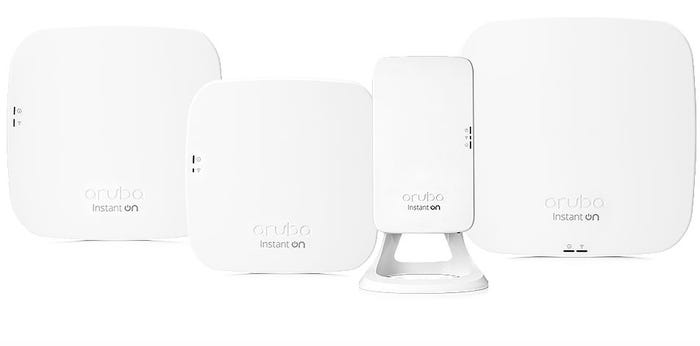Aruba Kicks Off New SMB Unit with Low-Cost Wireless Access Points
Aruba launches new Instant On Wi-Fi gear for SMBs starting at $119.
June 13, 2019
Aruba Networks is making its first push into the lower end of the small and medium business market with a new portfolio of entry-level wireless access points that the company will sell only through indirect channels. The introduction of the Instant On wireless access point line, which will have a starting list price of $119 each, is the outgrowth of an SMB business unit Aruba formed last month.
Hewlett Packard Enterprise, Aruba’s parent company, tapped longtime HPE exec Amol Mitra as the general manager and vice president of a new SMB business unit. HPE has accelerated its own SMB push and now sees growth in that segment for Aruba, which operates as a separate business that offers enterprise network gear. Aruba launched the new Instant On line at its Atmosphere EMEA conference in Croatia.

Aruba’s Lissa Hollinger
“We have predominantly focused on the enterprise and midmarket, historically, but have made the strategic decision to invest significantly and double down into the small business space,” said Lissa Hollinger, Aruba’s VP of product and solutions marketing. “Instant On effectively represents a new access point portfolio aimed at small businesses and is an extension to our existing extensive line of access points that are aimed at midmarket and enterprise, but this particular portfolio has been purpose-built for small business to address their product requirements, and also to get to a price point that’s palatable for this particular market.”
The Instant On portfolio is designed for organizations with 50-100 users actively connected to a network. Until now, Aruba has primarily competed with Cisco’s Meraki unit with larger network configurations. Its web portal management interface makes it well-suited for managed service providers, Hollinger said. “We’re seeing a lot of interest from the existing Aruba partners that want to build small business practices in this solution,” she said.
“It’s a reflection of the fact that as the midmarket and enterprise market matures, Aruba sees a greater opportunity in the SMB segment than they have seen before,” said analyst Rohit Mehra, IDC’s VP of network infrastructure. “Part of it is success of cloud-managed networking, but even more important is the success of vendors like Ubiquiti, Ruckus and others who have solely focused on the SMB space.”

Aruba’s InstantOn Product Family
The Instant On portfolio will arrive in the channel next month, consisting of one outdoor access point and four designed for installation indoors. The indoor units consist of the ceiling-mountable AP11, AP 12 and AP15, which offer 1167 Mbps, 1600 Mbps and 2033 Mbps bandwidth, respectively, supporting 50, 75 or 100 active devices. The AP11D, suited for small offices, boutique hotels and medical offices with up to 50 simultaneous connections, is wall or desk mountable. The weatherproof AP17 is for outdoor restaurants and other business that have small gathering areas.
More configurations and products from Aruba’s new SMB unit are in the pipeline, Hollinger said. Aruba’s initial crop of access points don’t support the latest wireless networking standard, 802.11ax, or Wi-Fi 6. Asked why, Hollinger said SMBs don’t require it today.
“We really don’t see the need within small businesses, but we will be monitoring that closely, and if the need does begin to arise, we would definitely consider introducing Wi-Fi 6 into this portfolio.”
Aruba was among the first to proclaim it was delivering Wi-Fi 6-capable access points last fall for enterprise customers. Hollinger underscored the fact that the new Instant On access points support …
… 802.11ac Wave 2, while many SMB solutions only support the first version of that protocol. The latter offers higher throughput, according to the Wi-Fi Alliance.
IDC’s Mehra agreed that most SMBs don’t need Wi-Fi 6, nor could Aruba or other vendors produce systems at the price point that small businesses can justify.
“You want to be price-competitive so you can penetrate the market and establish yourself within the first 12-18 months as a viable business unit,” he said.
Hollinger said Aruba is working now with its distribution partners to determine the types of incentives and marketing to attach to the new portfolio. Its key distributors are Arrow, D&H, Ingram Micro, ScanSource, Synnnex and Tech Data.
“We certainly have a recognition and a deep appreciation for the fact that things like offers and promotions in this space are going to be critical in order for us really penetrate this market and drive the growth,” she said. “We’re working with our distribution partners right now to come up with those plans. I don’t know if we’ll end up with one worldwide plan or whether those will be unique for each distribution partner, but we’re actively working on those plans right now.”
Read more about:
VARs/SIsAbout the Author
You May Also Like


